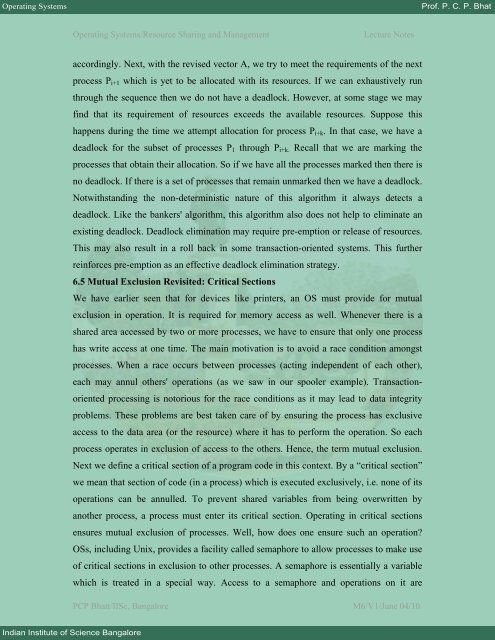Module 6: Resource Sharing and Management - E-Courses
Module 6: Resource Sharing and Management - E-Courses
Module 6: Resource Sharing and Management - E-Courses
You also want an ePaper? Increase the reach of your titles
YUMPU automatically turns print PDFs into web optimized ePapers that Google loves.
Operating Systems Prof. P. C. P. Bhat<br />
Indian Institute of Science Bangalore<br />
Operating Systems/<strong>Resource</strong> <strong>Sharing</strong> <strong>and</strong> <strong>Management</strong> Lecture Notes<br />
accordingly. Next, with the revised vector A, we try to meet the requirements of the next<br />
process Pi+1 which is yet to be allocated with its resources. If we can exhaustively run<br />
through the sequence then we do not have a deadlock. However, at some stage we may<br />
find that its requirement of resources exceeds the available resources. Suppose this<br />
happens during the time we attempt allocation for process Pi+k. In that case, we have a<br />
deadlock for the subset of processes P1 through Pi+k. Recall that we are marking the<br />
processes that obtain their allocation. So if we have all the processes marked then there is<br />
no deadlock. If there is a set of processes that remain unmarked then we have a deadlock.<br />
Notwithst<strong>and</strong>ing the non-deterministic nature of this algorithm it always detects a<br />
deadlock. Like the bankers' algorithm, this algorithm also does not help to eliminate an<br />
existing deadlock. Deadlock elimination may require pre-emption or release of resources.<br />
This may also result in a roll back in some transaction-oriented systems. This further<br />
reinforces pre-emption as an effective deadlock elimination strategy.<br />
6.5 Mutual Exclusion Revisited: Critical Sections<br />
We have earlier seen that for devices like printers, an OS must provide for mutual<br />
exclusion in operation. It is required for memory access as well. Whenever there is a<br />
shared area accessed by two or more processes, we have to ensure that only one process<br />
has write access at one time. The main motivation is to avoid a race condition amongst<br />
processes. When a race occurs between processes (acting independent of each other),<br />
each may annul others' operations (as we saw in our spooler example). Transactionoriented<br />
processing is notorious for the race conditions as it may lead to data integrity<br />
problems. These problems are best taken care of by ensuring the process has exclusive<br />
access to the data area (or the resource) where it has to perform the operation. So each<br />
process operates in exclusion of access to the others. Hence, the term mutual exclusion.<br />
Next we define a critical section of a program code in this context. By a “critical section”<br />
we mean that section of code (in a process) which is executed exclusively, i.e. none of its<br />
operations can be annulled. To prevent shared variables from being overwritten by<br />
another process, a process must enter its critical section. Operating in critical sections<br />
ensures mutual exclusion of processes. Well, how does one ensure such an operation?<br />
OSs, including Unix, provides a facility called semaphore to allow processes to make use<br />
of critical sections in exclusion to other processes. A semaphore is essentially a variable<br />
which is treated in a special way. Access to a semaphore <strong>and</strong> operations on it are<br />
PCP Bhatt/IISc, Bangalore M6/V1/June 04/10

















